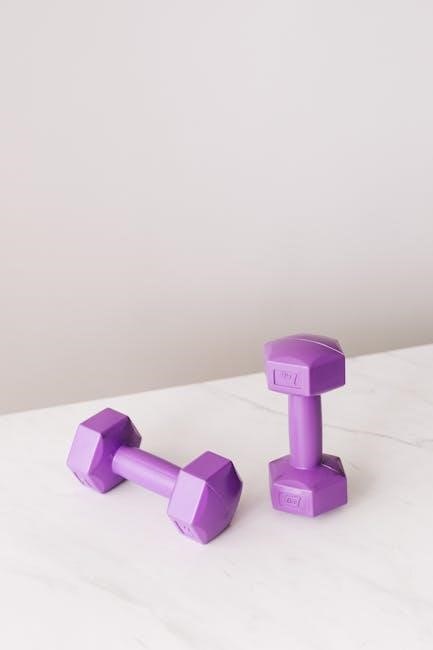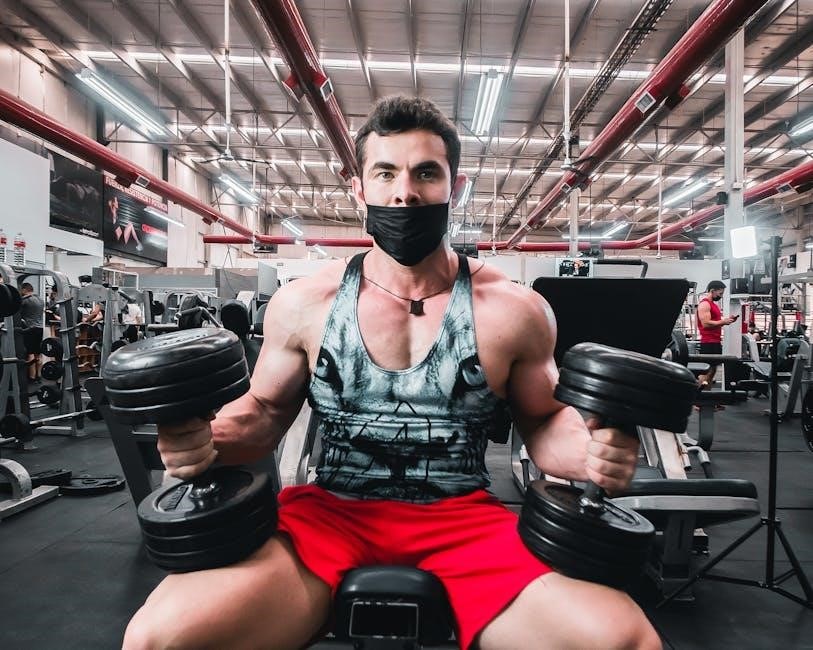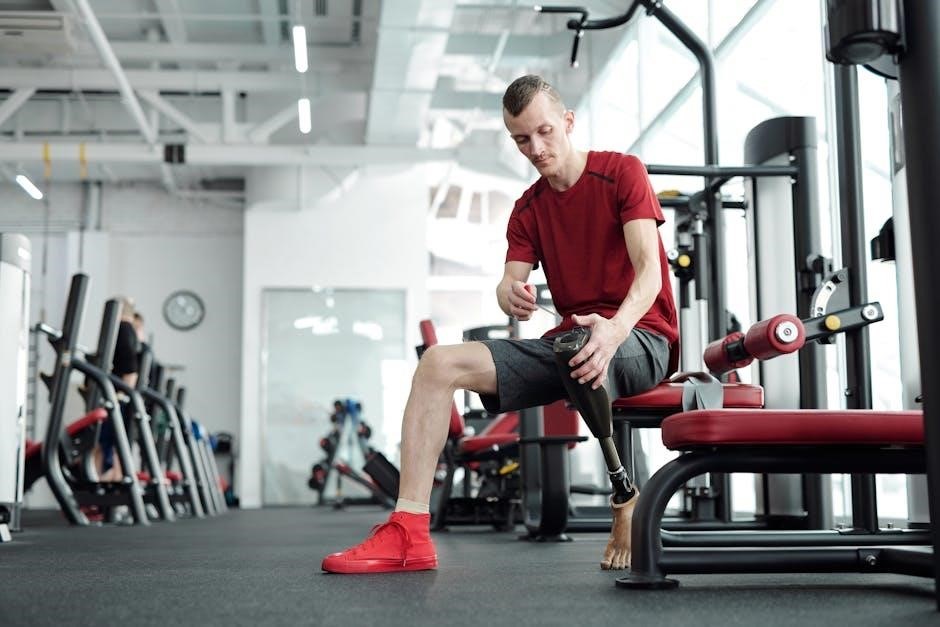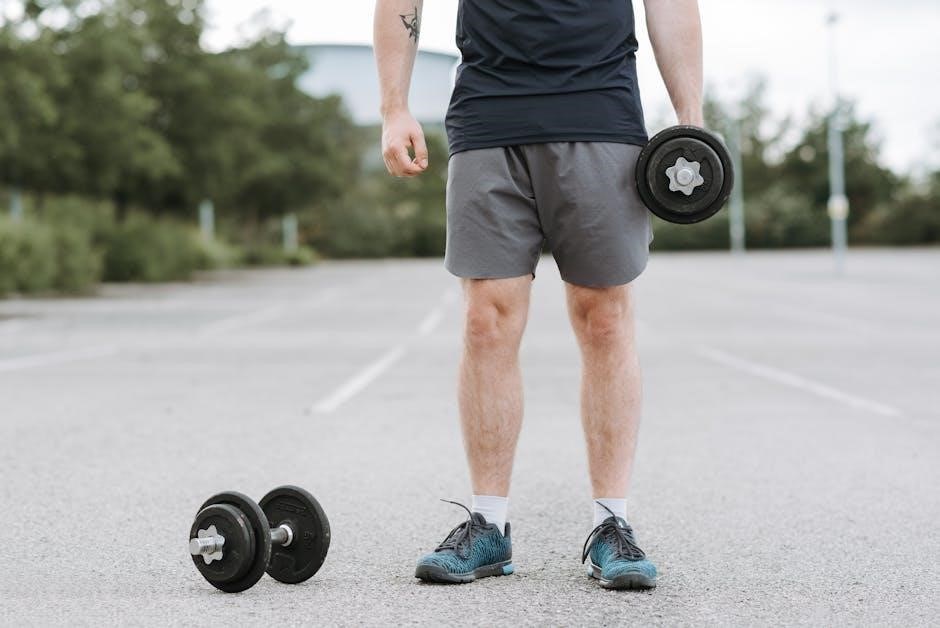Perfect for beginners, this 30-day no-equipment workout program offers a structured, progressive approach to fitness. Designed for home workouts, it requires no equipment, ensuring accessibility and convenience. Each day targets different muscle groups, blending strength, cardio, and rest days to enhance overall fitness and mobility progressively.
1.1 Understanding the Basics of Bodyweight Training
Bodyweight training uses your own weight as resistance to build strength, flexibility, and coordination. It’s a foundational approach that requires no equipment, making it accessible anywhere. Exercises like push-ups, squats, and planks target multiple muscle groups simultaneously, improving overall fitness. Proper form is crucial to prevent injuries and maximize results. Progression can be achieved by increasing repetitions, intensity, or modifying movements. This method is ideal for beginners, as it strengthens core muscles and enhances mobility. Bodyweight training also boosts cardiovascular health when performed in circuits or with minimal rest. It’s a versatile and effective way to start your fitness journey without any equipment.
1.2 Setting Realistic Fitness Goals for the 30-Day Challenge
Setting realistic fitness goals is essential for a successful 30-day no-equipment workout program. Start by assessing your current fitness level and lifestyle to create achievable objectives. Break your goals into smaller, manageable milestones, such as completing all workouts or increasing the number of repetitions. Track your progress daily using a journal or mobile app to stay motivated. Celebrate small victories, like mastering a new exercise or feeling more energetic. Remember, consistency is key, and focusing on long-term habits rather than quick fixes will yield better results. Adjust your goals as needed, but remain committed to your journey.

Benefits of a No Equipment Workout Program
A no-equipment workout program offers unmatched convenience, accessibility, and cost-effectiveness. It enhances overall fitness, mobility, and strength without requiring any specialized gear, making it ideal for home use.
2.1 Convenience and Accessibility
A no-equipment workout program offers unparalleled convenience, allowing you to exercise anywhere, anytime without gym memberships or bulky gear. This accessibility ensures consistency, making it easier to stick to your fitness routine. Whether at home, in a park, or while traveling, you can maintain your progress. The program eliminates barriers like cost and space, providing a flexible solution for busy schedules. Its simplicity encourages adherence, helping you stay committed to your fitness journey without interruptions.
2.2 Cost-Effectiveness
This 30-day workout program is highly cost-effective, requiring no investment in gym memberships, equipment, or accessories. By using bodyweight exercises, you save money while achieving fitness goals. It’s ideal for those on a budget or with limited access to workout facilities. Eliminating equipment costs makes it an affordable option for everyone. The program’s simplicity ensures you can stay fit without financial strain, making it a sustainable choice for long-term health and wellness. This accessibility allows you to allocate resources to other areas of your life while still prioritizing your fitness journey.
2.3 Improved Overall Fitness and Mobility
This program enhances overall fitness by improving strength, flexibility, and cardiovascular health through diverse exercises. Bodyweight workouts target multiple muscle groups, boosting mobility and coordination. Progressive intensity helps build endurance, while rest days ensure recovery. The combination of strength training and cardio activities promotes balanced fitness, making daily activities easier and reducing injury risk. Regular practice also enhances posture and joint health, contributing to long-term mobility. By focusing on functional movements, the program prepares the body for real-life challenges, ensuring holistic physical development. This approach fosters a strong, adaptable body capable of handling various physical demands with ease and confidence.

Weekly Breakdown of the 30-Day Workout Plan
This structured 30-day program is divided into four weeks, each focusing on specific muscle groups and progressively increasing intensity, ensuring balanced fitness and mobility.
3.1 Week 1: Building a Foundation
Week 1 focuses on establishing a solid fitness base with bodyweight exercises. It introduces essential movements like push-ups, squats, and planks to build strength and endurance. Each day targets different muscle groups, with a mix of full-body workouts and cardio exercises to improve mobility. Rest days are incorporated to allow recovery, ensuring the body adapts to the new demands. The exercises are designed to be manageable for beginners while gradually increasing intensity. By the end of Week 1, participants will have a clear understanding of proper form and a routine to follow, setting the stage for progressive overload in the coming weeks.
3.2 Week 2: Increasing Intensity
Week 2 ramps up the challenge by introducing more demanding bodyweight exercises and increasing the volume of work. Participants engage in higher-intensity workouts, such as burpees, mountain climbers, and tuck jumps, to boost cardiovascular fitness and strength. The focus shifts to improving endurance and muscle engagement, with exercises like plank variations, squats, and lunges performed in higher repetitions or time durations. HIIT (High-Intensity Interval Training) sessions are introduced to accelerate fat loss and enhance metabolic activity. Rest days remain crucial to allow muscle recovery and adaptation. By the end of Week 2, participants will notice improvements in stamina and overall physical performance, setting the stage for further progression.
3.3 Week 3: Focusing on Strength and Endurance
Week 3 emphasizes building strength and endurance through advanced bodyweight exercises. Workouts include variations like diamond push-ups, deep squats, and side lunges to target specific muscle groups. Core-strengthening exercises, such as planks, Russian twists, and leg raises, are intensified. HIIT sessions are extended to improve cardiovascular endurance, with bursts of high-intensity moves like jump squats and tuck jumps. Rest days are maintained to ensure recovery, but active recovery techniques like yoga or light stretching are encouraged. By this phase, participants should notice significant improvements in muscle tone, stamina, and overall physical resilience, preparing them for the final week’s challenges.
3.4 Week 4: Maximizing Results

Week 4 is designed to push participants to their limits, focusing on advanced bodyweight exercises to maximize strength, endurance, and fat loss. Workouts include high-intensity interval training (HIIT) sessions, extended sets of challenging movements like squat thrusters, and plyometric exercises such as burpees and jump squats. Core workouts are intensified with extended plank variations and dynamic movements. Rest days are replaced with light active recovery to maintain momentum. By the end of Week 4, participants should see significant improvements in overall fitness, with the final day featuring a full-body challenge to test their progress and celebrate their transformation over the 30-day journey.

Sample Workouts for Each Day
This section provides detailed daily workouts, such as Day 1’s full-body routine with push-ups, squats, and mountain climbers, ensuring variety and progression throughout the 30-day plan.
4.1 Day 1: Full Body Workout
Start your fitness journey with a dynamic full-body workout designed to engage all major muscle groups. Begin with 10 push-ups to strengthen your chest and arms, followed by 10 squats to target your legs and core. Next, perform 10 lunges per leg for balanced lower body strength. Conclude with 10 mountain climbers to boost cardiovascular endurance and 10 plank shoulder taps to enhance core stability. This routine sets the foundation for your 30-day program, ensuring a balanced approach to building strength and endurance from day one. Keep the pace steady and focus on proper form to maximize results and prevent injury.
4.2 Day 5: Core and Cardio Focus
By Day 5, focus on intensifying your core strength and cardiovascular endurance. Begin with 15-20 seconds of planks to stabilize your core, followed by 15 Russian twists per side to target obliques. Perform 20 bicycle crunches for a dynamic core workout. Transition to cardio with 30 seconds of jumping jacks, followed by 30 seconds of mountain climbers to elevate your heart rate. Conclude with 10-15 minutes of steady-state cardio, such as brisk walking or jogging in place. This workout enhances core stability, improves cardiovascular health, and boosts metabolism. Keep your pace steady and focus on maintaining proper form to avoid injury and maximize results.
4.3 Day 10: Upper Body Strength
On Day 10, focus on building upper body strength with a dynamic workout. Start with 15 push-ups to engage your chest and triceps, followed by 12 wide-arm push-ups to target the chest more intensely. Perform 10 tricep dips using a sturdy chair or bench to strengthen the back of your arms. Complete 15 plank shoulder taps to challenge your shoulders and core stability. Finish with 10 Superman exercises to strengthen your lower back and 10 side planks (each side) to engage your obliques. Conclude with a 5-minute wall slide to improve shoulder mobility and strength. This routine enhances upper body power and endurance effectively.
4.4 Day 15: Lower Body and Mobility
Day 15 focuses on strengthening the lower body and improving mobility. Begin with 15 bodyweight squats to engage your quadriceps and hamstrings. Follow with 12 lunges (per leg) to target balance and leg strength. Perform 10 glute bridges to activate your glutes and improve hip mobility. Complete 15 calf raises to strengthen your lower legs. For mobility, incorporate 10 deep knee bends and 10 side lunges to enhance flexibility. Conclude with a 5-minute stretching routine, including seated hamstring stretches, hip flexor stretches, and calf stretches. This workout enhances lower body power, stability, and range of motion, preparing you for more intense routines ahead.
4.5 Day 20: HIIT for Fat Loss
Day 20 introduces a high-intensity interval training (HIIT) session designed to maximize fat loss and boost cardiovascular fitness. Start with 3 rounds of 20 seconds of burpees followed by 40 seconds of rest. Next, perform 3 sets of 15 jump squats and 15 mountain climbers, resting for 30 seconds between sets. Continue with 3 rounds of 20-second sprint-in-place and 40-second rest. Finish with 3 sets of 10 plank jacks and 10 tuck jumps, resting for 30 seconds between sets. This intense workout accelerates metabolism, burns calories, and improves endurance. Rest for 1-2 minutes between exercises if needed to maintain form and intensity.
4.6 Day 25: Active Recovery
Day 25 focuses on active recovery to rejuvenate your body and mind. Begin with 10 minutes of gentle jogging or brisk walking to boost blood flow. Follow with a 10-minute yoga flow, incorporating poses like downward dog, child’s pose, and cobra stretch to enhance flexibility. Perform 3 sets of 15 bodyweight squats and 15 lunges at a slow, controlled pace to maintain mobility. Conclude with 5 minutes of deep breathing exercises to relax and reduce muscle tension. This active recovery day helps your body heal while keeping you moving, ensuring you’re prepared for the final push toward Day 30.
4.7 Day 30: Final Full Body Challenge
Day 30 is your ultimate full-body challenge, testing strength, endurance, and determination. Start with 15 burpees, followed by 20 jump squats and 30 mountain climbers to ignite your heart rate. Transition into 15 push-ups, 20 tricep dips (using a chair), and 25 bicycle crunches for core engagement. Conclude with 10 minutes of HIIT: 30 seconds of intense effort (e.g., sprints in place) followed by 30 seconds of rest, repeating for the duration. Finish strong with a 1-minute plank hold. Hydrate thoroughly and celebrate your progress. This final workout encapsulates your 30-day journey, showcasing your growth and commitment to fitness.

Incorporating Rest and Recovery
Rest days are essential for muscle repair and growth, preventing overtraining. Active recovery, like yoga or light stretching, enhances flexibility and reduces soreness, supporting overall progress.
5.1 The Importance of Rest Days
Rest days are crucial for allowing your muscles to repair and grow, preventing overtraining and injury. Without adequate rest, your body cannot recover, which may lead to decreased performance and motivation. Rest days also help prevent mental burnout, ensuring you stay consistent with your workout routine. Incorporating rest days into your 30-day program helps maintain progress, as muscle growth and strength improvements occur during recovery, not just during exercise. Listen to your body and embrace rest days as a vital component of your fitness journey, supporting long-term success and overall well-being.
5.2 Active Recovery Techniques
Active recovery involves low-intensity activities that promote muscle repair and flexibility without overexertion. Techniques include light yoga, stretching, or short walks. These activities enhance blood flow, reduce muscle soreness, and improve mobility. Unlike passive rest, active recovery keeps you moving gently, aiding recovery while maintaining momentum. Incorporating activities like yoga or mobility exercises on rest days can refresh both body and mind, ensuring you return to workouts stronger; This approach complements rest days, supporting overall progress and helping you stay consistent with your 30-day program. Balance active recovery with proper rest to optimize results and prevent burnout.

Nutrition Tips for Optimal Results
A balanced diet rich in protein, healthy fats, and complex carbs fuels your workouts and supports recovery. Stay hydrated to enhance performance and aid muscle repair. Avoid processed foods to maximize results and maintain energy levels throughout your 30-day journey.

6.1 Balanced Diet for Muscle Growth and Fat Loss
A balanced diet is essential for supporting both muscle growth and fat loss during your 30-day workout program. Focus on consuming lean proteins like chicken, fish, and eggs to build and repair muscle tissue. Incorporate complex carbohydrates such as whole grains, fruits, and vegetables to provide sustained energy for your workouts. Healthy fats, including avocados and nuts, are crucial for hormone production and overall health. Aim to eat 5-6 smaller meals throughout the day to maintain metabolism and prevent excessive hunger. Avoid processed foods and sugary drinks to ensure your diet aligns with your fitness goals. Portion control and calorie balance are key.
6.2 Hydration and Its Role in Recovery
Proper hydration is crucial for recovery during your 30-day workout program. Water makes up 60% of your body and plays a key role in muscle repair, joint health, and energy levels. Aim to drink at least 8-10 glasses of water daily, adjusting for sweat loss during intense workouts. Even mild dehydration can reduce performance and delay recovery. Incorporate water-rich foods like cucumbers and oranges to boost hydration. Aim to drink water before, during, and after workouts to replenish lost fluids. Staying hydrated ensures your body functions optimally, supporting muscle growth and fat loss while minimizing muscle soreness and fatigue.

Staying Motivated Throughout the Program
Staying motivated requires tracking progress, finding accountability, and celebrating milestones. Consistency is key; maintain a schedule and reward achievements to keep momentum throughout the program.

7.1 Tracking Progress
Tracking progress is essential to staying motivated. Use a workout journal to record exercises, reps, and sets completed daily. Take progress photos and measurements weekly to visualize changes. Celebrate small victories, like mastering a new exercise or increasing endurance, to stay encouraged. Monitoring improvements helps maintain consistency and reinforces the commitment to the program. Seeing measurable results boosts confidence and keeps the focus on long-term goals, ensuring accountability and drive throughout the 30-day journey.
7.2 Finding Accountability
Accountability is key to staying consistent with your workout plan. Share your fitness goals with a friend or mentor and ask them to check in on your progress. Joining an online fitness community or local workout group can also provide motivation and support. Use reminders on your phone or schedule workouts in your calendar to stay committed. Reporting your daily progress to a partner or online group ensures you stay on track. Sharing achievements on social media can also foster accountability and encouragement from others. Building a support system helps maintain discipline and motivation throughout the 30-day program.
7.3 Celebrating Milestones
Celebrating milestones is a powerful way to stay motivated during your 30-day workout journey. Recognize progress, no matter how small, such as completing a challenging workout or mastering a new exercise. Acknowledge non-scale victories like increased energy or better sleep. Reward yourself with healthy treats or new workout gear to stay inspired. Share your achievements with friends or online communities to gain encouragement. Celebrating milestones reinforces commitment and provides a sense of accomplishment, helping you stay driven to reach your fitness goals. This positive reinforcement ensures consistent effort and builds confidence for the remainder of the program.
Congratulations on completing the 30-day no-equipment workout program! Reflect on your journey, celebrate progress, and use this momentum to continue your fitness path. Stay consistent and keep striving for new goals ahead.
8.1 Evaluating Your Fitness Journey
Evaluating your fitness journey after the 30-day program is crucial to understanding your progress. Track key metrics like strength, endurance, and weight loss. Celebrate milestones, no matter how small, to stay motivated. Reflect on challenges faced and how you overcame them. Use this insight to refine your goals and plan future workouts. Progress photos and fitness logs can provide visual evidence of your transformation. Acknowledge improvements in energy levels, mobility, and overall well-being. This evaluation will help you set realistic expectations and guide your next steps in maintaining a long-term fitness routine.
8.2 Continuing Your Fitness Path Beyond 30 Days
After completing the 30-day program, maintaining momentum is key. Gradually increase workout intensity or duration to continue challenging yourself. Explore various exercise types, such as strength training or cardio, to keep your routine engaging. Join fitness communities or find a workout buddy for motivation. Track your progress consistently to monitor improvements and stay accountable. Consider setting new, achievable goals to keep your fitness journey exciting. Remember, consistency is vital, and small, incremental changes lead to lasting results. By embracing fitness as a lifestyle, you can sustain your progress and enjoy long-term health benefits beyond the initial challenge.
